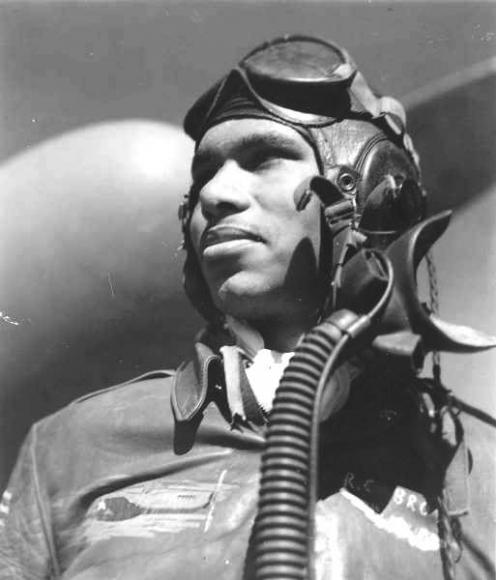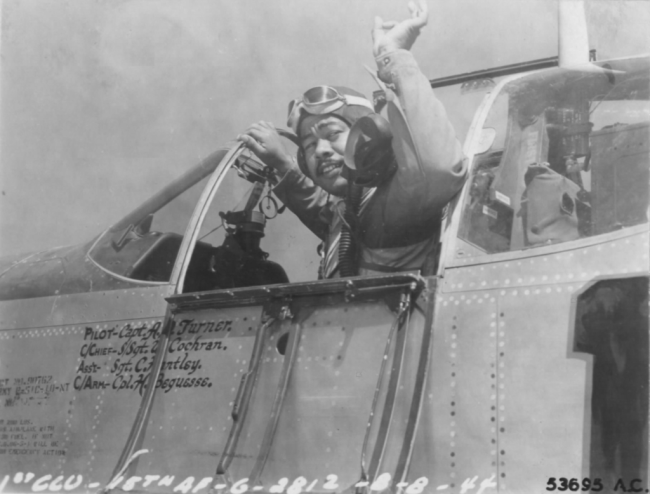100th Fighter Squadron
Squadron
P-51D-15-NA #44-15648 "Lollipoop II" Code: #10 Roger Freeman Collection
Corrected caption
Object Number - FRE 8701 - A P-51 Mustang (10) of the 332nd Fighter Group. Handwritten caption on reverse: 'Genuine WWII colour photo, Mustang Fossia (sp. Foggia) Italy.'...
Established in February 1942 at Tuskegee Army Airfield, Alabama to train African-American flight cadets graduated from the Tuskegee Institute Army contract flying school. At Tuskegee, the squadron performed advanced combat flying training. As the number of graduated from the Tuskegee school grew, two additional squadrons the 301st and 302d Fighter Squadrons were activated at Tuskegee Army Airfield, forming the 332d Fighter Group.
Due to the segregated status of the Army Air Forces in 1942 and the reluctance by the service to deploy African Americans into combat, the 332d remained in an extended training status. The Group was transferred to Selfridge Army Air Base, near Detroit, Michigan in March 1943 after the decision was reached to deploy the unit. Racial tensions in the Detroit area, however, forces a move to Oscoda Army Airfield, in isolated northeast Michigan the next month where the final training of the unit was performed by First Air Force. However, the unit was delayed again going into combat, and also was sent back to Selfridge upon completion of training at Oscoda AAF to perform Air Defense flights over the Detroit area beginning in July 1943.
For six months, the unit remained at Selfridge until pressure on the Army led to the decision to deploy the 100th to the Fifteenth Air Force in Italy at the end of 1943, under the command of Robert B. Tresville, to support the strategic aerial bombardment campaign being carried out by Boeing B-17 Flying Fortress and Consolidated B-24 Liberator Heavy bombers from newly established air bases in the Foggia, Italy area.
As the Italian Campaign pushed further north into Italy during 1944, the squadron moved to operate from forward captured air bases, flying bomber escort missions initially with Republic P-47D Thunderbolts, then being upgraded to the long-range North American P-51D Mustang fighter. In combat, the unit engaged enemy forces in the Rome-Arno area, then during the D-Day landings in France, took part in the Normandy and Northern France campaigns. It returned to the MTO in August 1944, flying combat missions supporting the Invasion of southern France and attacking enemy targets in Northern Italy, Po Valley, the German Rhineland and the Western Allied invasion of Germany during March and April 1945.
With the end of the War in Europe in May 1945, the squadron was returned to Southern Italy, being stationed at Lucera Airfield, near Foggia where the unit slowly was demobilized and personnel returned to the United States. The 100th Fighter Squadron was inactivated as an administrative unit at Camp Kilmer, New Jersey in mid-October 1945
Connections
See how this entry relates to other items in the archive by exploring the connections below.
Unit stations
| Station | Location | Date |
|---|---|---|
Encompassing

- Unit Hierarchy: Group
- Air Force: Twelfth Air Force
- Type Category: Fighter
People

- Military/Civilian/Mascot: Military
- Nationality: American
- Unit: 332nd Fighter Group 100th Fighter Squadron
- Service Numbers: 34462478 / O-824827
- Highest Rank: Second Lieutenant
- Role/Job: Pilot

- Military/Civilian/Mascot: Military
- Nationality: American
- Unit: 332nd Fighter Group 100th Fighter Squadron
- Service Numbers: O-824828
- Highest Rank: Captain
- Role/Job: Fighter Pilot / Squadron Commander

- Military/Civilian/Mascot: Military
- Nationality: American
- Unit: 332nd Fighter Group 100th Fighter Squadron
- Service Numbers: O-824830
- Highest Rank: Second Lieutenant
- Role/Job: Pilot

- Military/Civilian/Mascot: Military
- Nationality: American
- Unit: 332nd Fighter Group 100th Fighter Squadron
- Service Numbers: O-798943
- Highest Rank: First Lieutenant
- Role/Job: Fighter Pilot

- Military/Civilian/Mascot: Military
- Nationality: American
- Unit: 332nd Fighter Group 100th Fighter Squadron
- Service Numbers: 12124614 / O-798945
- Highest Rank: Captain
- Role/Job: Fighter Pilot
Aircraft
- Aircraft Type: P-51 Mustang
- Unit: 332nd Fighter Group 100th Fighter Squadron
- Aircraft Type: P-51 Mustang
- Unit: 332nd Fighter Group 100th Fighter Squadron

- Aircraft Type: P-51 Mustang
- Unit: 332nd Fighter Group 100th Fighter Squadron

- Aircraft Type: P-47 Thunderbolt
- Nicknames: Ruthless Ruthie
- Unit: 325th Fighter Group 317th Fighter Squadron 332nd Fighter Group 100th Fighter Squadron
- Aircraft Type: P-51 Mustang
- Unit: 332nd Fighter Group 100th Fighter Squadron





